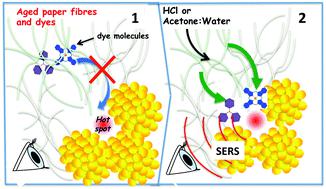当前位置:
X-MOL 学术
›
Phys. Chem. Chem. Phys.
›
论文详情
Our official English website, www.x-mol.net, welcomes your
feedback! (Note: you will need to create a separate account there.)
Spotting aged dyes on paper with SERS
Physical Chemistry Chemical Physics ( IF 2.9 ) Pub Date : 2020-09-29 , DOI: 10.1039/d0cp04099a Alfonso Zoleo 1, 2, 3, 4 , Cecilia Rossi 1, 2, 3, 4 , Giovanna Poggi 4, 5, 6, 7 , Marta Rossi 4, 5, 6, 7 , Moreno Meneghetti 1, 2, 3, 4 , Piero Baglioni 4, 5, 6, 7
Physical Chemistry Chemical Physics ( IF 2.9 ) Pub Date : 2020-09-29 , DOI: 10.1039/d0cp04099a Alfonso Zoleo 1, 2, 3, 4 , Cecilia Rossi 1, 2, 3, 4 , Giovanna Poggi 4, 5, 6, 7 , Marta Rossi 4, 5, 6, 7 , Moreno Meneghetti 1, 2, 3, 4 , Piero Baglioni 4, 5, 6, 7
Affiliation

|
Surface enhanced Raman spectroscopy (SERS) is a highly sensitive technique for the non- or minimally invasive identification of molecules at very low concentrations. In this work, SERS is exploited using naked laser-ablated gold nanoparticles (AuNPs) for the detection of dyes on artificially aged paper inked with a ballpoint pen. Although several studies on inks with SERS are present in the literature, most of them report on the investigations on freshly prepared products, and less information is present on the detection of aged dyes and inks using SERS. Ballpoint inks are commonly used in daily activities, but have also been employed by several contemporary artists. These inks are very sensitive to light, and they discolor rapidly, making their detection demanding. In the present work, the SERS spectra of a ballpoint pen ink on two types of paper were analyzed after light-induced ageing, and the importance of the dye–AuNP interaction is discussed. The results show that the interpretation of the SERS spectra of the aged samples, such as those of interest in the Cultural Heritage field, is a tricky and delicate operation and that the diffusion of the dyes to the hot spot regions of the plasmonic nanoparticles plays a pivotal role in the detection of degraded ink components. Therefore, appropriate evaluation of the factors affecting the molecule–plasmonic nanoparticle interactions and of the history of the artwork to be analyzed is fundamental to avoiding the misinterpretation of the spectra and, consequently, of the original composition of the analyzed artwork.
中文翻译:

用SERS在纸上发现老化的染料
表面增强拉曼光谱(SERS)是一种非常灵敏的技术,可用于非侵入式或微创式非常低浓度的分子鉴定。在这项工作中,利用裸露的激光烧蚀金纳米颗粒(AuNPs)来开发SERS,以检测用圆珠笔着墨的人工老化纸上的染料。尽管文献中已有几项关于使用SERS的墨水的研究,但大多数研究报告了对新鲜制备产品的研究,而使用SERS检测老化的染料和墨水的信息较少。圆珠笔墨水通常用于日常活动中,但也被一些当代艺术家所采用。这些油墨对光非常敏感,并且会迅速褪色,从而要求进行检测。在目前的工作中,在光致老化后,分析了两种类型的纸上的圆珠笔墨水的SERS光谱,并讨论了染料与AuNP相互作用的重要性。结果表明,对老化样品(例如,文化遗产领域中感兴趣的样品)的SERS光谱的解释是一项棘手且微妙的操作,并且染料向等离子纳米颗粒热点区域的扩散起着重要作用。在检测降解的墨水成分中起关键作用。因此,对影响分子与等离子体纳米粒子相互作用的因素以及待分析艺术品的历史进行适当评估,对于避免对谱图以及由此对所分析艺术品的原始成分产生误解至关重要。并讨论了染料与AuNP相互作用的重要性。结果表明,对老化样品(例如,文化遗产领域中感兴趣的样品)的SERS光谱的解释是一项棘手且微妙的操作,并且染料向等离子纳米颗粒热点区域的扩散起着重要作用。在检测降解的墨水成分中起关键作用。因此,对影响分子与等离子体纳米粒子相互作用的因素以及待分析艺术品的历史进行适当评估,对于避免对谱图以及由此对所分析艺术品的原始成分产生误解至关重要。并讨论了染料与AuNP相互作用的重要性。结果表明,对老化样品(例如,文化遗产领域中感兴趣的样品)的SERS光谱的解释是一项棘手且微妙的操作,并且染料向等离子纳米颗粒热点区域的扩散起着重要作用。在检测降解的墨水成分中起关键作用。因此,对影响分子与等离子体纳米粒子相互作用的因素以及待分析艺术品的历史进行适当评估,对于避免对谱图以及由此对所分析艺术品的原始成分产生误解至关重要。这是一个棘手且微妙的操作,染料向等离子纳米粒子热点区域的扩散在检测降解的墨水成分中起着关键作用。因此,对影响分子与等离子体纳米粒子相互作用的因素以及待分析艺术品的历史进行适当评估,对于避免对谱图以及由此对所分析艺术品的原始成分产生误解至关重要。这是一个棘手且微妙的操作,染料向等离子纳米粒子热点区域的扩散在检测降解的墨水成分中起着关键作用。因此,对影响分子与等离子体纳米粒子相互作用的因素以及待分析艺术品的历史进行适当评估,对于避免对谱图以及由此对所分析艺术品的原始成分产生误解至关重要。
更新日期:2020-10-20
中文翻译:

用SERS在纸上发现老化的染料
表面增强拉曼光谱(SERS)是一种非常灵敏的技术,可用于非侵入式或微创式非常低浓度的分子鉴定。在这项工作中,利用裸露的激光烧蚀金纳米颗粒(AuNPs)来开发SERS,以检测用圆珠笔着墨的人工老化纸上的染料。尽管文献中已有几项关于使用SERS的墨水的研究,但大多数研究报告了对新鲜制备产品的研究,而使用SERS检测老化的染料和墨水的信息较少。圆珠笔墨水通常用于日常活动中,但也被一些当代艺术家所采用。这些油墨对光非常敏感,并且会迅速褪色,从而要求进行检测。在目前的工作中,在光致老化后,分析了两种类型的纸上的圆珠笔墨水的SERS光谱,并讨论了染料与AuNP相互作用的重要性。结果表明,对老化样品(例如,文化遗产领域中感兴趣的样品)的SERS光谱的解释是一项棘手且微妙的操作,并且染料向等离子纳米颗粒热点区域的扩散起着重要作用。在检测降解的墨水成分中起关键作用。因此,对影响分子与等离子体纳米粒子相互作用的因素以及待分析艺术品的历史进行适当评估,对于避免对谱图以及由此对所分析艺术品的原始成分产生误解至关重要。并讨论了染料与AuNP相互作用的重要性。结果表明,对老化样品(例如,文化遗产领域中感兴趣的样品)的SERS光谱的解释是一项棘手且微妙的操作,并且染料向等离子纳米颗粒热点区域的扩散起着重要作用。在检测降解的墨水成分中起关键作用。因此,对影响分子与等离子体纳米粒子相互作用的因素以及待分析艺术品的历史进行适当评估,对于避免对谱图以及由此对所分析艺术品的原始成分产生误解至关重要。并讨论了染料与AuNP相互作用的重要性。结果表明,对老化样品(例如,文化遗产领域中感兴趣的样品)的SERS光谱的解释是一项棘手且微妙的操作,并且染料向等离子纳米颗粒热点区域的扩散起着重要作用。在检测降解的墨水成分中起关键作用。因此,对影响分子与等离子体纳米粒子相互作用的因素以及待分析艺术品的历史进行适当评估,对于避免对谱图以及由此对所分析艺术品的原始成分产生误解至关重要。这是一个棘手且微妙的操作,染料向等离子纳米粒子热点区域的扩散在检测降解的墨水成分中起着关键作用。因此,对影响分子与等离子体纳米粒子相互作用的因素以及待分析艺术品的历史进行适当评估,对于避免对谱图以及由此对所分析艺术品的原始成分产生误解至关重要。这是一个棘手且微妙的操作,染料向等离子纳米粒子热点区域的扩散在检测降解的墨水成分中起着关键作用。因此,对影响分子与等离子体纳米粒子相互作用的因素以及待分析艺术品的历史进行适当评估,对于避免对谱图以及由此对所分析艺术品的原始成分产生误解至关重要。











































 京公网安备 11010802027423号
京公网安备 11010802027423号